TRAINING THE GRIP BY DENNIS MARTIN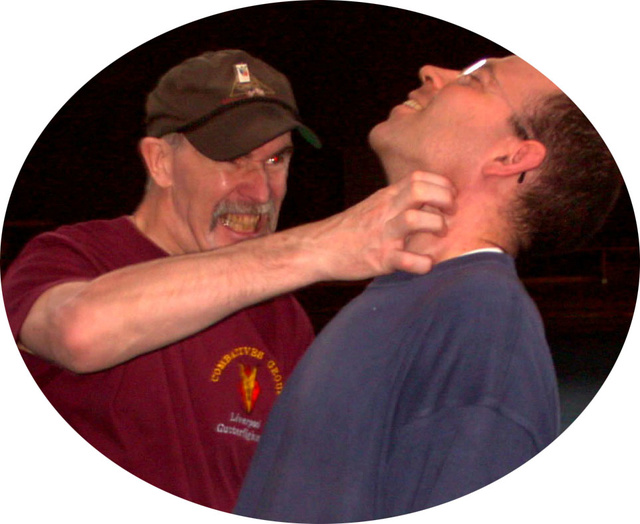
We are great believers in task-oriented fitness training for self-protection. In future website articles we will address specific aspects of fitness training for combatives. We will start by looking at an area of particular interest, the grip.
RELEVANCE
Why should you train for grip power? Well, maybe you don't need to. I've met numerous men with naturally powerful grips. If you regularly train with heavy weights, or, work in certain manual occupations you may be already getting all the grip training you need for self protection. However, most of us could probably benefit from a program of specific grip training.
Under intense psychogenic stress the body prepares to survive by a neurological surge, followed by an immediate hormonal dump. This makes us faster, stronger and more resistant to shock. One of the effects is that our grip strength increases by approximately 10%. Now if our inbuilt survival mechanism places such importance on grip, it seems to me that we should take this as a clue; and train to enhance this essential resource even more.
Most close combat occurs at contact distance, where grabbing takes place. Some primary offensive techniques, recommended by Fairbairn, and other notables, are grasping/crushing the testicles, crushing the windpipe, and the face-claw which gouges the eyes.
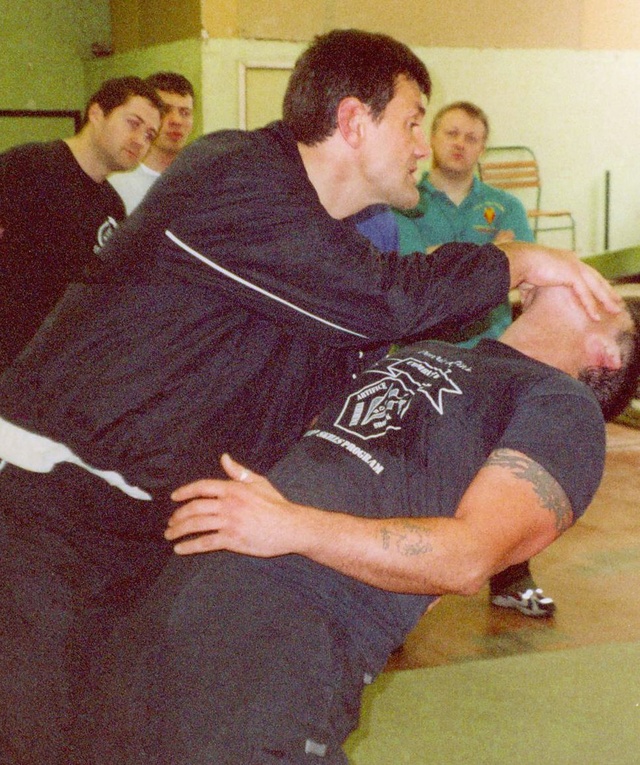
These techniques depend on grip strength.
Controlling a wildly aggressive enemy, by grabbing his limbs, or, clothing to direct him to the ground, or pull him off balance, or into your strike, also requires a decent grip.
Finally, the use of weapons generally depends on hand strength. Impact weapons, such as batons, are subject to severe impact shock when hitting bone. You need to maintain your grip to stay in the fight. Edged weapons, too, put stress on the grip. When stabbing through clothing, flesh and bone your hand can slip onto the blade, especially if wet with sweat or blood. An enemy stabbed in the chest cavity can collapse instantly, and you suddenly have 200lbs-plus dead weight on your blade. Maintaining grip integrity can be a problem.
Even firearms may require grip training. Double action weapons in particular have heavy triggers, which many smaller operators, including females, have difficulty managing. A progressive fitness build-up, emphasising grip training is a pre-requisite in this case.
The hand is the interface between the operator and the weapon itself. It is essential that this critical connection is not the weak link in the chain, but fully contributes to winning the fight. The following exercises and equipment will provide some ideas
TYPES OF GRIP
Gripping is one of our most natural actions, ever since we lived in the trees. Depending on the situation, what we are gripping, (the size, material and shape) and why we are gripping (to pull, push, rip, twist etc) we use the hand in various ways. Some of these include:-
PINCH GRIP, using the fingers together with the thumb.
CRUSH GRIP, which uses the fingers as a unit closing to the palm.
PARTIAL GRIP, situationally you may grip with just a couple of digits. It’s important to train each finger to peak strength. Much training is done with a complete grip, with the thumb locked over the fingers. Although usual when working out with dumb-bells, for example, it is not the best way to train the fingers. Preferable is the active grip, where the fingers must grip hard throughout the exercise, without the thumb providing stability.
TRAINING
Before doing any heavy training it is essential to warm up, and this applies just as much to grip training as any other resistance work you do. The following points should be observed
1] I recommend fully warming up, getting the heart-rate up, breaking a light sweat before specific training.
2] Loosen up the joints, especially the fingers, wrists and elbows, using standard callisthenics.
3] My favourite grip warm-up is to stand with the arms extended to the front, with elbows bent about 90°and palms up. Quickly roll the fingers closed into a fist, thumb locking down, then instantly extend to fully open. This is one rep. Do thirty reps, then slowly grip, using maximum strength, for a count of five, then slowly extend, locking the fingers open ,again for five seconds. This 30 fast/ one slow sequence is one set. For warming up do three sets. You may want to do more, as a grip development exercise, and that's fine, but just as a warm up three sets is enough. When doing this exercise concentrate on working just the fingers. Avoid the forearms bouncing up and down, isolate just the hands.
4] Push-ups on fingers are a good general warm up. Start on all fingers, bent into claws and do at least ten reps. This alone serves as a warm up. To work on individual digital strength, remove the little finger and do another ten reps. Continue removing a finger from the support until just on thumbs. Refer to the photo showing this exercise.

This is best done on a mat, or other resilient surface, at first. Later, work on a hard wood floor.
GRIP DEVICESWe will now discuss some of the devices which are designed specifically for grip development. There are numerous pieces of equipment on the market, and I haven’t used them all. Of the stuff I've used some is rubbish. The following are the ones I can recommend.
OKINAWAN GRAVEL BAG
While training on Okinawa I was introduced to a very applicable and simple, piece of equipment.
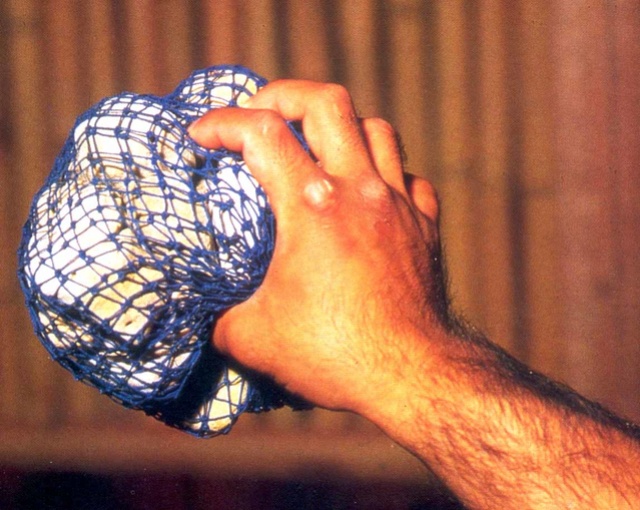
A canvas bag (a bank cash bag will do) is filled with small gravel, and suspended from a cord. You strike it with your left Spearhand to set it swinging, then as it returns you grab it with your right, crushing the bag as tightly as possible. Release, then repeat. Obviously, change the striking order after a time. This works on applying the fingers as a spearing weapon, and as a “grip and rip†requiring speed of grip as well as crushing force. This is excellent for combatives training, as we often need a reactive, fast grip rather than to slowly pulverise. While on Okinawa I became very fond of using another device:-
THE OKINAWAN JARS
Known as Kame these pottery jars are gripped by the rim and carried, lifted or twisted in various ways. As you become stronger sand, gravel or irons can be placed inside.
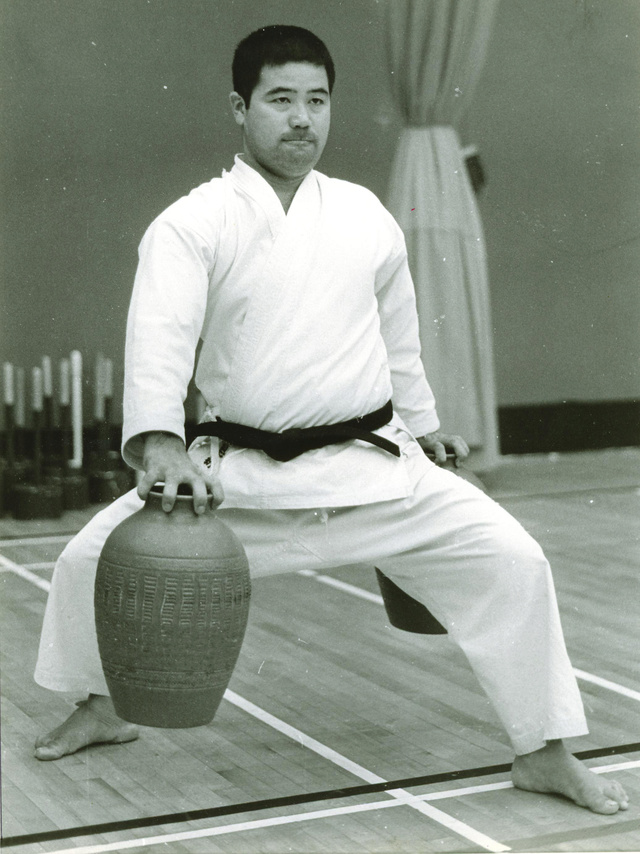 [Master Higaonna with the kame jars]
[Master Higaonna with the kame jars]The jars are ideal for overall grip development, as they include the thumb. If you know any guys in Okinawan Goju-ryu they should be able to provide a source for the jars. If not, then doing pinch-grips with a barbell plate gives similar benefits. The hard conditioning of Okinawan Karate is largely irrelevant to self-protection, but these grip methods are worthwhile.
PLASTICINE
While undergoing physiotherapy on my finger following an accident I was introduced to the use of a block of plasticine, or clay. With the wrist stabilised on the table each finger is individually pulled through the resistant medium. Additionally, each finger is pushed through the block, training the extensors too. All in all a first class, and very specific training device. My physiotherapist also had me use a device I was already familiar with:-
THE GRIPMASTER DEVICE
This resembles a conventional z-spring gripper, but rather than a bar for the fingertips there are individual pistons.
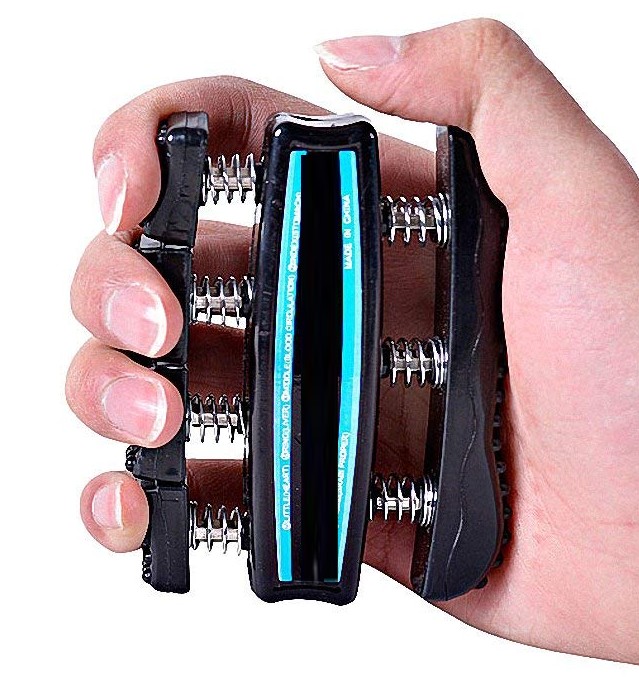
Originally designed for rock climbers this device was quickly adopted by target pistol shooters, who need to use the trigger finger disarticulated from the other gripping digits, for very precise trigger control. Ideal for individual finger strength this device is widely available in UK shops, and is offered in different strengths.
The instruction sheet packaged with the device shows several good exercises, including a method of exercising each individual finger against the thumb, thus fully involving, and strengthening, the thumb.
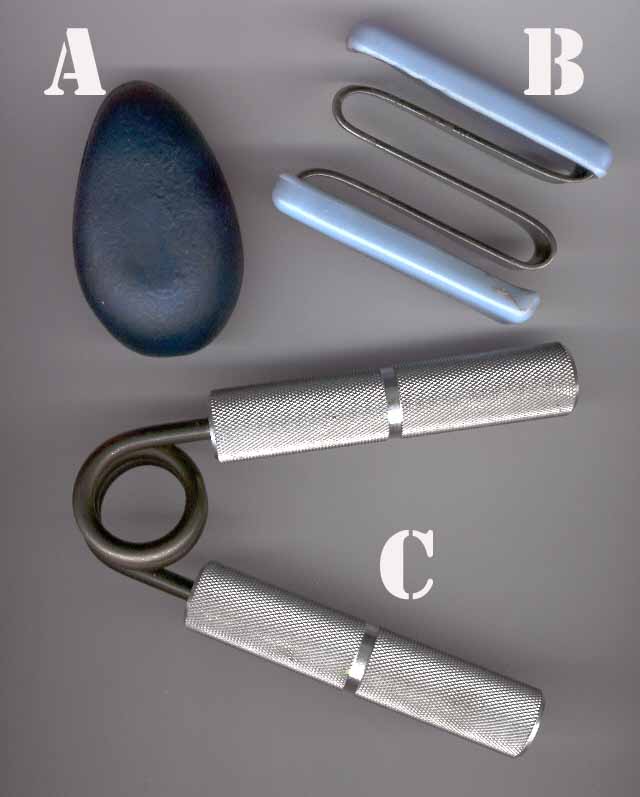
[
Grip devices which are discussed below]RUBBER BALLS
These have long been used in hand training. A solid sphere of dense rubber can be squeezed, for either reps, or endurance. The egg pictured [in the grip devices photo "A"] is my favourite, as it contours the shape of the gripping hand.
Another device marketed as SnowBalls consists of a ball covered in latex, filled with rice. This provides a different feel to the exercise. Note, those with a decent grip often pulverise the rice to powder fairly quickly.
SPRING GRIP DEVICES
There is a whole family of spring devices, basically offered in nutcracker format, or, as Z-shape format [see Grip devices photo "B"] These are very popular, and many an hour has been whiled away squeezing these instruments. Terry O'Neill has one in his car, and we have grip contests on long journeys.
IRONMIND
Recently I've been using the products of a company called IronMind, who market a whole range of training equipment, including numerous grip devices, such as Titan's Telegraph Key and Eagle Loops Their spring grippers are called Captains of Crush and they have taken training to a new level. [Grip devices photo "C"] As soon as you pick one up you know these are heavy duty training implements. No plastic or wood, these have handles made from knurled alloy, just like barbell handles. The IronMind training philosophy is different.
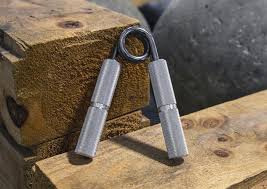
Captains of Crush are not designed to be squeezed repeatedly while watching TV, or, driving your car. They are for serious, specific training, following a full warm up. Low reps, full grips. When you can do the target number, you move up to the next level. Captains of Crush have five levels, the initial trainer model, then levels 1-4. When you can do about ten reps with your current model, you move up to the next level, and you probably won't be able to perform a single full closure! You continue working with your previous model, as a warm up, and to build up for the current one. The higher levels are fearsome, and, at time of writing, there is only one man on the planet who has closed the Number Four. After working with Captains of Crush you will really notice the results.
When training to the limit, with devices such as Captains of Crush, you will reach a plateau, where progress stalls. Here supplementary work on the foundations of the grip will be a benefit. Wrist-roller drills, wrist-curls and other forearm exercises will build up the muscles involved in the grip, and progress will resume.
————-
There are numerous other devices, hand webs, eagle-springs etc. Some are good, others not worth bothering with. Over the years innovative instructors have come up with numerous ideas to enhance grip strength, and to condition the operator for combat. Military CQB instructors often used finger wresting as a precursor to hand-to-hand and firearms training. Wartime combatives expert Eric Anthony Sykes could crush a raw potato.
Wrapping thick material, such as canvas, around a punchbag, then tightly gripping it with the offhand, as you reeve in strikes with the other hand, is very applicable training.
Another good exercise involves doing pushups using Softballs. I bought a pair, tried it, and it is a really direct way to train for the Face Claw. By the way, Softballs, used in the variation of Baseball, are anything but soft!
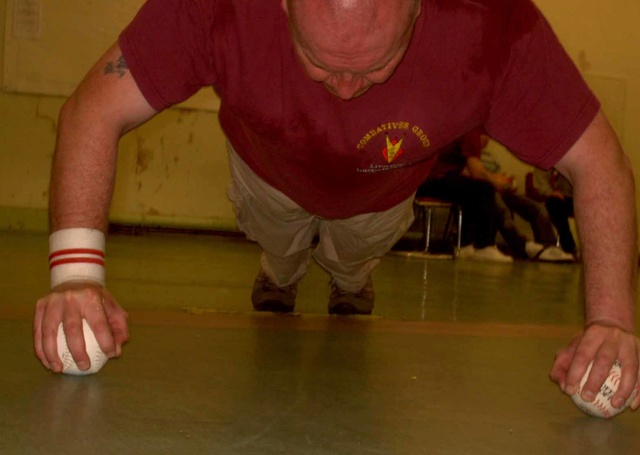
[Larry, from the Liverpool Gutterfighters demonstrates SoftBall pushups.
Note, in the picture below, the weight is over the fingers, not the palm, this ensures that the fingers are fully involved]

The Wrist-roller, familiar to bodybuilders is also useful....
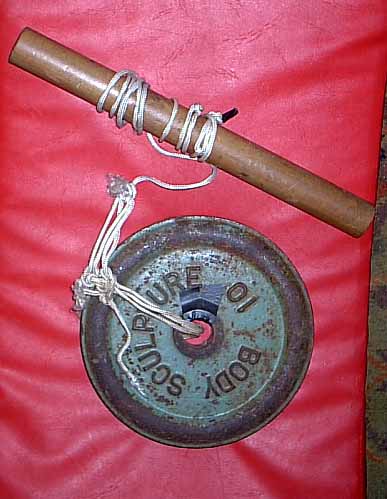
…. it develops the muscles of the forearms which are the source of the grip.
LESSONS FROM THE INTERNATIONAL SEMINAR At the 2006 International Combatives Seminar we had a section called “The Strong Shall Survive” where I invited instructors especially noted for their expertise in power training to discuss and demonstrate specific methods. John Brawn presented the Kettlebell, Larry Blundell showed Medicine Ball work, and others discussed Brick PT. All of these methods have implications for grip training as follows.
The Kettlebell is on old training device, which has been rediscovered by several astute instructors. John Brawn demonstrated how the Kettlebell is ideal for Combatives strength training. The device can also be used for grip power too, by hanging the bell off the fingertips, and curling the fingers.
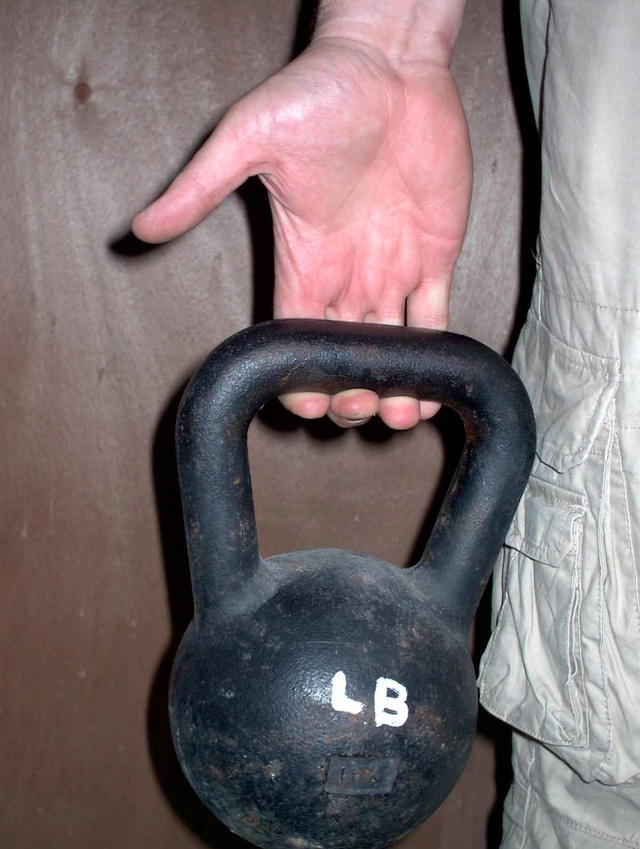
The updated Medicine Ball, incorporating handles is being used increasingly in our training. Among the many grip-related exercises is a two-partner push/pull drill.
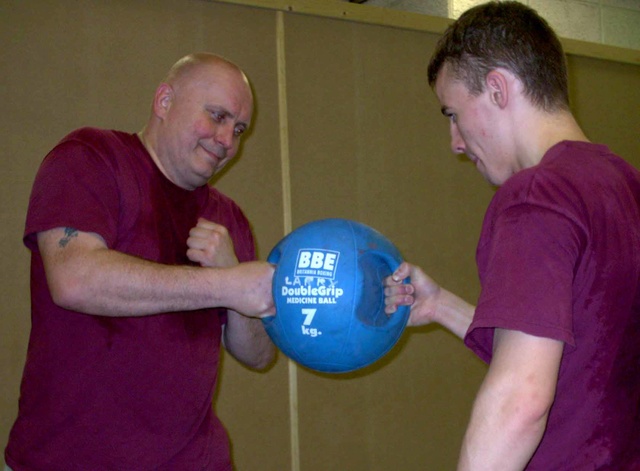 [Larry and Brian, from the Liverpool Gutterfighters, show a Medicine ball drill]
[Larry and Brian, from the Liverpool Gutterfighters, show a Medicine ball drill]The staff explained how using bricks can be an easily available source of resistance training, developing core-strength,with the bonus of an active grip throughout the exercise.
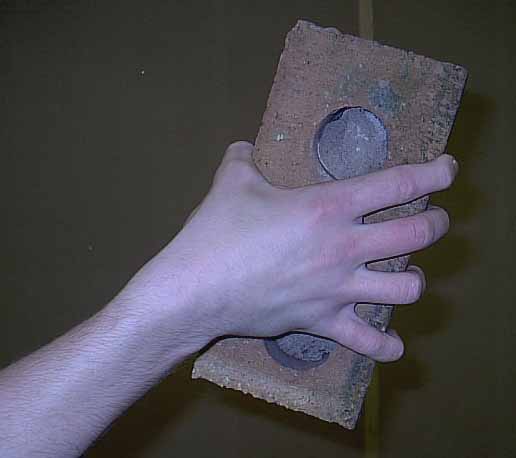
Bricks are cheap and easy to obtain, and a whole class can participate in Brick PT.
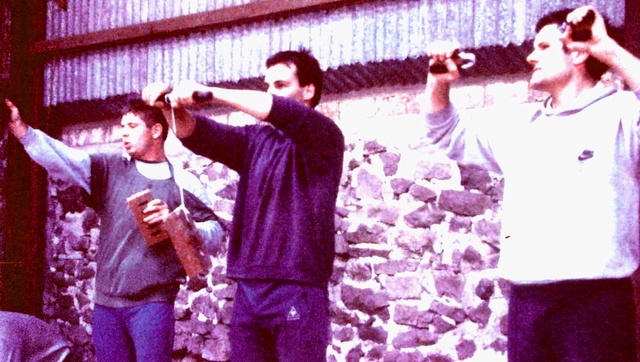
[Here a group of trainees go through various grip training routines on our Bodyguard Course in about 1987. Left to right, Brick PT, Wrist-roller, Handgrips.]
DEXTERITY
Following a grip workout I strongly suggest doing some dexterity work. Exercises which isolate the fingers individually are a good start. Twirling a pencil, or, coin from finger to finger, doing weapon manipulation drills, playing piano/guitar, even conjuring tricks are all excellent. The fingertips are hot-wired to the brain, and digital dexterity drills access and stimulate the areas of the brain concerned with grip, providing a sort of "mental workout"
A really applicable after-training dexterity routine is to do some access/opening drills with a Tactical Folding Knife, or, do do some manipulation load/unload/mag-change dry training with your pistol.
CLOSE COMBAT Our primary resource is striking; the delivery of massive shock-impact. However there are a number of realistic situations where it is not possible to generate the momentum required for the strike. If pinned down, or, rammed into a corner, if off balance, if dazed we may be denied the primary option. It's now that gouging, crushing, twisting and ripping come to the forefront, and these are enhanced by a powerful grip.
Training for a strong, fast, tenacious grip is just one part of preparing for self-protection, but it's a significant part. When you come to grips with a determined enemy, such power is an asset.
————–
RESOURCES
Source for books and training equipment. IronMind. PO Box 1228, Nevada City CA 95959, USA. Phone (530)-265-6725. E-Mail
sales@ironmind.comThe GripMaster device is available
here]here[/i]
